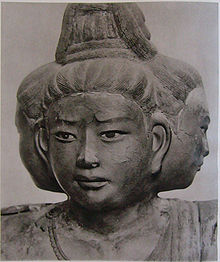
In the mid-6th century, the introduction of Buddhism from Korea (Baekje) to Japan resulted in a revival of Japanese sculpture. Buddhist monks, artisans and scholars settled around the capital in Yamato Province (present day Nara Prefecture) and passed their techniques to native craftsmen. Consequently, early Japanese sculptures from the Asuka and Hakuhō periods show strong influences of continental art, which initially were characterized by almond-shaped eyes, upward-turned crescent-shaped lips and symmetrically arranged folds in the clothing. The workshop of the Japanese sculptor Tori Busshi, who was strongly influenced by the Northern Wei style, produced works which exemplify such characteristics. The Shakyamuni triad and the Guze Kannon at Hōryū-ji are prime examples. By the late 7th century, wood replaced bronze and copper. By the early Tang dynasty, greater realism was expressed by fuller forms, long narrow slit eyes, softer facial features, flowing garments and embellishments with ornaments such as bracelets and jewels. Two prominent examples of sculptures of this period are the Shō Kannon at Yakushi-ji and the Yumechigai Kannon at Hōryū-ji.[1][2][3]
During the Nara period, from 710 to 794, the government established and supported workshops called zōbussho, the most prominent of which was located in the capital Nara at Tōdai-ji, which produced Buddhist statuary. Clay, lacquer and wood, in addition to bronze, were used. Stylistically, the sculptures were influenced by the high Tang style, showing fuller body modelling, more natural drapery and a greater sense of movement. Representative examples of Nara period sculpture include the Great Buddha and the Four Heavenly Kings at Tōdai-ji, or the Eight Legions at Kōfuku-ji.[4]
Early Heian period works before the mid-10th century appear heavy compared to Nara period statues, carved from single blocks of wood, and characterised by draperies carved with alternating round and sharply cut folds. Stylistically, they followed high to later Tang style. In the Heian period the zōbussho were replaced with temple-run and independent workshops; wood became the primary medium; and a specific Japanese style emerged. By the mid-10th century, the style was refined presenting a more calm and gentle appearance, with attenuated proportions. Jōchō was the most important sculptor of this time, and he used the yosegi technique, in which several pieces of wood are joined to sculpt a single figure. He was the ancestor of three important schools of Japanese Buddhist statuary: the Enpa, Inpa and Keiha school. The Amida Nyorai at Byōdō-in is the only extant work by Jōchō.[4][5][6] Japanese sculpture experienced a renaissance during the Kamakura period, led by the Kei school. Partially influenced by Song dynasty China, their sculpture is characterised by realism featuring elaborate top knots, jewelry, and wavy drapery. Although predominantly wooden, bronze was also used as a material for the statues. As a novelty, portrait sculptures of prominent monks were created adjacent to the depiction of Buddhist deities.[7]
The term "National Treasure" has been used in Japan to denote cultural properties since 1897.[8] The definition and the criteria have changed since the inception of the term. These sculptures adhere to the current definition, and have been designated national treasures since the Law for the Protection of Cultural Properties came into force on June 9, 1951. The items are selected by the Ministry of Education, Culture, Sports, Science and Technology based on their "especially high historical or artistic value".[9][10] This list presents 141 entries of sculptures, including those from Classical and early Feudal Japan of the 7th-century Asuka period to the 13th-century Kamakura period, although the number of sculptures is higher, because groups of related sculptures have sometimes been joined to form single entries. The sculptures listed depict Buddhist and Shintō deities or priests venerated as founders of temples. Some of the most ancient sculptures were imported directly from China.[10][11]
- ^ Cite error: The named reference
stat-asukawas invoked but never defined (see the help page). - ^ "Other Buddhist images of the Asuka period". Asuka Historical Museum. 1995. Retrieved 2009-09-16.
- ^ Schumacher, Mark (2009). "Buddhist sculpture in Hakuho era". Japanese Buddhist Statuary. Archived from the original on 2020-11-12. Retrieved 2009-09-16.
- ^ a b Schumacher, Mark (2009). "Buddhist sculpture in Nara era". Japanese Buddhist Statuary. Archived from the original on 2021-01-24. Retrieved 2009-09-16.
- ^ Schumacher, Mark (2009). "Buddhist sculpture in Heian era". Japanese Buddhist Statuary. Archived from the original on 2021-01-25. Retrieved 2009-09-16.
- ^ F. Moran, Sherwood (1972). "Early Heian Sculpture at Its Best: Three Outstanding Examples". Artibus Asiae. 34 (2/3). Artibus Asiae Publishers: 119–161. doi:10.2307/3249644. JSTOR 3249644.
- ^ Schumacher, Mark (2009). "Buddhist sculpture in Kamakura era". Japanese Buddhist Statuary. Archived from the original on 2021-01-25. Retrieved 2009-09-16.
- ^ Coaldrake, William Howard (2002) [1996]. Architecture and authority in Japan. London, New York: Routledge. p. 248. ISBN 0-415-05754-X. Archived from the original on 2023-02-19. Retrieved 2021-08-22.
- ^ "Cultural Properties for Future Generations" (PDF). Tokyo, Japan: Agency for Cultural Affairs, Cultural Properties Department. March 2017. Archived from the original (PDF) on 2017-12-16. Retrieved 2017-12-17.
- ^ a b Cite error: The named reference
ACAwas invoked but never defined (see the help page). - ^ Ogawa, Seki & Yamazaki 2009